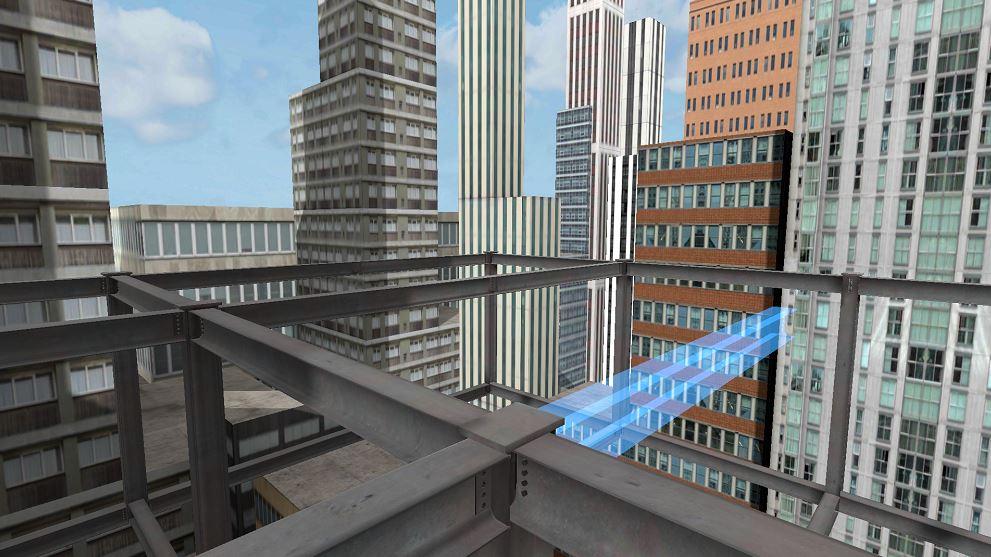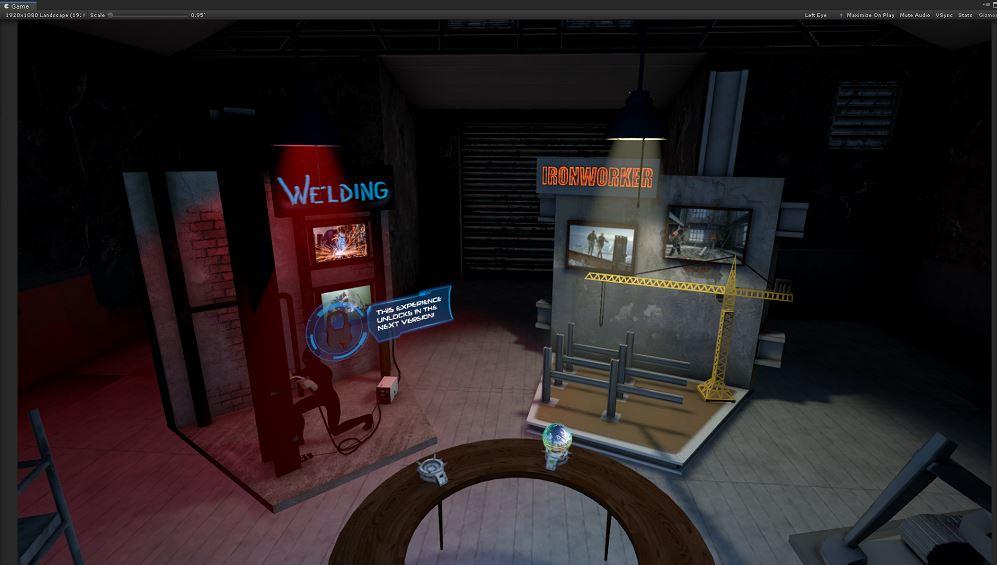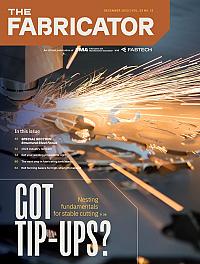Senior Editor
- FMA
- The Fabricator
- FABTECH
- Canadian Metalworking
Categories
- Additive Manufacturing
- Aluminum Welding
- Arc Welding
- Assembly and Joining
- Automation and Robotics
- Bending and Forming
- Consumables
- Cutting and Weld Prep
- Electric Vehicles
- En Español
- Finishing
- Hydroforming
- Laser Cutting
- Laser Welding
- Machining
- Manufacturing Software
- Materials Handling
- Metals/Materials
- Oxyfuel Cutting
- Plasma Cutting
- Power Tools
- Punching and Other Holemaking
- Roll Forming
- Safety
- Sawing
- Shearing
- Shop Management
- Testing and Measuring
- Tube and Pipe Fabrication
- Tube and Pipe Production
- Waterjet Cutting
Industry Directory
Webcasts
Podcasts
FAB 40
Advertise
Subscribe
Account Login
Search
How VR can attract the next gen of structural fabricators
Structural steel industry veteran embraces virtual reality technologies
- By Tim Heston
- December 7, 2023
- Article
- Shop Management

Using technology facilitated by Industry Lift, VR gamers see how a steel beam fits into the larger structure, and what the experience is like being a steel erector. Images: Industry Lift
Bill Issler of the 1970s probably couldn’t imagine the Bill Issler of the 2020s. A business major and an avid gymnast, he was voted as one of the most outstanding college athletes in America in 1975. Today you might see him at a tradeshow, donning headsets, showing attendees how virtual and augmented reality (VR and AR) could draw a new generation of talent into the structural fabrication and detailing arena.
His career took a winding path. It brought him through steel detailing to software development, from DOS to Windows, detailing software, and management information systems (MISs) for structural fabricators, covering estimating, purchasing, and workflow. When Trimble (Tekla’s parent company) purchased FabSuite in 2018, Issler pursued another calling. He had already taken a keen interest in VR and AR, especially considering its potential in training, communication, and attracting new people to the industry.
He remembered back to his college days, when he was unaware of a host of industries and jobs he’d eventually experience throughout his career. Lucky for the structural steel industry, Issler’s uncles were in the steel detailing business. If that hadn’t been the case, his life might have taken a very different path.
Many don’t know career paths in structural steel even exist, and the same goes for plenty of other skilled professions. Potential career paths lie hidden, unknown to most high school and even college graduates. By launching a public benefit corporation called Industry Lift in 2018, Issler aimed to ensure those career paths don’t remain hidden.
All Boats Rise
Issler first learned of AR and VR being used in structural steel around 2016. He visited a FabSuite customer that happened to be using a Microsoft HoloLens headset for a construction project. When workers donned the headsets, they could see a 3D model of a building—right there on the table in front of them. That 3D model showed how cranes could pick beams in just such a way to ensure optimal loading and efficiency. Steel erection had entered the 21st century.
“I was utterly fascinated. I’ve always tried to grow the industry by bringing technology to it,” Issler said. “I’m not necessarily the inventor of the technology. Instead, I find people who are using it, then bring awareness of it to others so it can be used in other places.”
Shortly after this, Issler acquired more VR and AR equipment and built a training center with a 16-ft. video wall at FabSuite headquarters in Virginia. When Issler sold the company, he retained those training assets.
“I was able to keep all the VR ideas I had as well as that training facility, and I wanted to repurpose it.”
His former customers at FabSuite all had the same problem: They couldn’t find the right people to hire, especially welders. After Issler sold the company, he had time and resources—including a training center with VR and AR equipment—to start uncovering solutions.
“Consider the structural steel supply chain,” he said. “You’ve got the contractor, the architect, the engineers, the structural steel fabricators, the steel suppliers, the warehouses and service centers, and the equipment suppliers. If any one of those supply chain players wants to get better, they need to get lower prices from their suppliers or higher prices from their customers. That’s individual thinking. If you raise the water level, you lift all boats. What can we do to lift the whole industry?”

Ever wonder what it takes to complete a bolted connection on a high rise? VR can give gamers an idea.
From that question came Industry Lift. Issler teamed up with IT and coding expert Alberto Boin, based in Switzerland. Issler had worked with Boin for years, starting in his FabSuite days, and now the two had the opportunity to start something new.
“Alberto really is the inspiration and brains behind all of this,” Issler said. “We couldn’t have done it individually, but working together, we made it happen.”
Start With the Grandsons
Issler had been observing how younger people absorbed information and, more broadly speaking, interacted with the world. “I saw my grandsons play with these VR headsets, and I saw how they took to them. They grew up in a world of devices. How could we build a VR experience to introduce careers they never considered before?”
Through his years at FabSuite, he knew that most people outside steel construction (or even in different areas of construction) really didn’t know anything about what it takes to fabricate steel. They knew welding, at least, but they didn’t really know what it felt like to hold a welding gun or work in a fab shop or in the field. What’s steel detailing? A connection engineer? A steel erector?
So many young people have no idea what to do with their lives. Even with modern tech and the information superhighway, they remain utterly unaware of a multitude of career paths—not just in structural steel, but in numerous sectors that take up vast swaths of the U.S. economy. Regardless of their educational experience, so many jump into an industry because of a friend or family member, or by happy chance. There’s nothing wrong with serendipity, but it won’t solve this country’s skilled labor crisis.
Many don’t pursue a career because they simply don’t know it exists. So they attend college, accumulate debt, perhaps even drop out, then struggle professionally for years. What if they were introduced to careers years before, with more than just a brief description?
Click to Experience a Career
From these discussions came several programs associated with Issler and Industry Lift that are just now getting off the ground. JobLand is a kind of virtual amusement park, experienced through a web browser or VR headset, where people can discover and try out a multitude of jobs within different industries, all in the context of an online multiplayer game. “The idea is to have challenging, career-immersing game experiences,” Issler said.
The entire “world” is organized via supply chain. Someone might click to learn about welding, then move upstream to machine operation or perhaps downstream to trucking or steel erection.
“In our structural steel supply chain, we’ve got a welding game, a forklift game, and a steel erector game. For the steel erector game, you stand on a high-rise building, and you grab a beam and put it into place,” Issler said. “It’s not everything an erector does, of course, but it exposes you to what it is.”
Designers broke the JobLand universe down via company and job classifications (NAICS codes) defined by federal statistical agencies. And within each, gamers can click to another site, VR Museums, to explore all the different career options within that industry. For instance, gamers can walk through a “museum” that shows all the different players in the structural steel supply chain. They can click to explore a specific entity, like a structural steel fab shop. They see virtual models of branded machines from various companies supporting the project. (With sponsor support, Industry Lift aims to keep the entire gaming experience free for users.) They also can click on certain workstations to play specific games, such as welding. They then see what the next related job is, be it a fitter or machine operator upstream, or a fork truck driver or steel erector downstream.

Gamers can “walk” to various stations to enter a VR game designed to give users a taste of what the job is really like.
“This way, you learn about all the jobs in a supply chain pictorially and then virtually,” Issler said. Gamers can even explore upstream to detailing and engineering. “Each one has its own virtual world to explore, but they’re all connected.”
Breaking Down Walls
At this writing, many games are still in development or have early iterations released to the public. As these games evolve and become more immersive, designers will work to incorporate best practices, particularly when it comes to safety and industry-specific codes. But some companies do operate differently—think of the differing levels of building information modeling (BIM) adoption through structural fabrication.
“These games will show all the variations, and we won’t choose one as a prime method,” Issler said. For instance, some structural fabricators have in-house detailing, others do not, and games will evolve to reflect both realities.
All this relates to a bigger idea. The aim isn’t just to expose young people to potential career paths, but also broaden their perspective and break down those artificial supply chain barriers that create so many inefficiencies. Throwing work “over the wall” to another department or supplier (with people thinking, “It’s not my problem anymore; it’s my supplier’s problem”) happens everywhere, but it can be particularly acute in construction.
“[Virtual reality] games could be educational to round out your understanding of the whole supply chain,” Issler said. “That’s how you lift up an entire industry.”
About the Author

Tim Heston
2135 Point Blvd
Elgin, IL 60123
815-381-1314
Tim Heston, The Fabricator's senior editor, has covered the metal fabrication industry since 1998, starting his career at the American Welding Society's Welding Journal. Since then he has covered the full range of metal fabrication processes, from stamping, bending, and cutting to grinding and polishing. He joined The Fabricator's staff in October 2007.
subscribe now

The Fabricator is North America's leading magazine for the metal forming and fabricating industry. The magazine delivers the news, technical articles, and case histories that enable fabricators to do their jobs more efficiently. The Fabricator has served the industry since 1970.
start your free subscription- Stay connected from anywhere

Easily access valuable industry resources now with full access to the digital edition of The Fabricator.

Easily access valuable industry resources now with full access to the digital edition of The Welder.

Easily access valuable industry resources now with full access to the digital edition of The Tube and Pipe Journal.
- Podcasting
- Podcast:
- The Fabricator Podcast
- Published:
- 04/16/2024
- Running Time:
- 63:29
In this episode of The Fabricator Podcast, Caleb Chamberlain, co-founder and CEO of OSH Cut, discusses his company’s...
- Trending Articles
Tips for creating sheet metal tubes with perforations

Are two heads better than one in fiber laser cutting?

Supporting the metal fabricating industry through FMA

JM Steel triples capacity for solar energy projects at Pennsylvania facility

Omco Solar opens second Alabama manufacturing facility

- Industry Events
16th Annual Safety Conference
- April 30 - May 1, 2024
- Elgin,
Pipe and Tube Conference
- May 21 - 22, 2024
- Omaha, NE
World-Class Roll Forming Workshop
- June 5 - 6, 2024
- Louisville, KY
Advanced Laser Application Workshop
- June 25 - 27, 2024
- Novi, MI



























